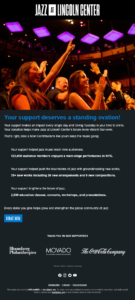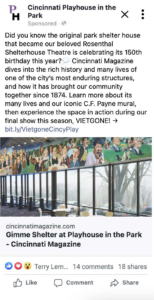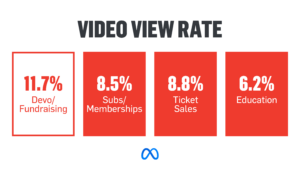If you work in arts and culture, you don’t need another headline telling you that funding is facing immense strain. Federal grants are shrinking (or cut entirely), state budgets are shifting in precarious ways, and inflation is stretching every dollar thin. But in uncertain times, a strong, engaged community can be a powerful stabilizer—and smart marketing is key in building and harnessing that community.
For organizations navigating rocky financial terrain, marketing isn’t just about selling tickets. It’s about telling a compelling story, forging deeper audience connections, and ensuring donors (and potential donors) understand why your organization matters. It’s a small but mighty piece of the larger funding puzzle. Here’s how arts and cultural organizations can use marketing to weather the shifting funding landscape of 2025.
THE REALITY OF FUNDING IN 2025
Government Support: A Mixed Bag
The arts and cultural sector contributes over $1.1 trillion to the U.S. economy. Yet despite its sizable impact, public funding remains volatile and prone to disruptions.
According to SMU DataArts, government grants have made up a growing portion of arts and cultural funding since 2021, but that momentum is slowing as pandemic relief programs wind down.
The new administration recently added insult to injury by narrowing the National Endowment for the Arts’ budget and scope, cutting grant opportunities for programs that support diversity initiatives and historically excluded communities. They also moved to dismantle the Institute of Museum and Library Services, a key funding source for museums, zoos, aquariums, botanical gardens, and historic sites.
At the state level, overall arts appropriations are expected to drop by 10% in fiscal year 2025—still better than pre-pandemic levels, but not exactly comforting. It also remains unclear how recent federal restrictions on the types of programs funded will trickle down to state arts associations.
Private Funding: More From Foundations, Less From Individuals
Private foundations have increased their support for arts and cultural institutions in recent years, but individual, trustee, and corporate donations haven’t kept up with inflation. Some donors may continue giving the same dollar amount year after year because they’re unaware that rising costs reduce the impact of their contributions. Others, including retirees on fixed incomes or donors in the workforce balancing other financial commitments, may simply not have the capacity to give more.
With government support fluctuating and private giving struggling to keep pace with rising costs, arts and cultural organizations must build and harness engaged communities to serve as support networks during this time of financial uncertainty—and marketing is a key player in this success.
MARKETING AS A CRITICAL TOOL FOR FINANCIAL STABILITY
If nothing else, the uncertainty of the past few months has highlighted the need to diversify funding sources and refine messaging to show donors why their support matters now more than ever. Here are four marketing tactics to support your endeavors:
1. Make It Clear That You’re a Nonprofit
It may seem obvious to us, but research from IMPACTS Experience shows that less than half of Americans know that nonprofit cultural institutions are, in fact, nonprofits. And here’s the kicker: people are more likely to donate when they understand an organization’s nonprofit status.
So, what’s the fix? Create content that highlights your mission, community impact, and the tangible ways your organization serves the public. Audiences may only know you as the place they go to see concerts; don’t assume they know the rest. Share real stories of artists, educators, and audiences who benefit from your work. The more you connect the dots for potential donors, the more likely they are to step up.
LOS ANGELES PHILHARMONIC
Content Angle: Share Artists’ Stories
What they did: L.A.’s home orchestra created documentary-style videos spotlighting youth orchestra participants.
NEW YORK CITY BALLET
Content Angle: Highlight Community Impact
What they did: This top-tier ballet company used video to showcase its breadth of educational offerings.
JAZZ AT LINCOLN CENTER
Content Angle: Show Where The Money Goes
What they did: This iconic New York institution used email to underscore the impact of donations.

2. Invest in Institutional Campaigns
Most marketing dollars go toward selling tickets, but what about marketing your organization itself? Institutional campaigns—also known as brand campaigns—help audiences understand your year-round impact beyond any single show or exhibition. They keep your organization top of mind even during the slower months, and create deeper audience connections that lead to long-term support.
Consider running an evergreen paid media campaign that highlights your mission, showcases community impact, and invites audiences to be part of something bigger. These efforts build loyalty and lay the groundwork for future ticket sales and donor appeals. When funding gets tough, a loyal audience can make all the difference.
Does the idea of an ‘always on’ campaign feel impossible on your budget? Start small—begin with a campaign that lasts a few weeks in advance of your peak sales periods. A lead up to a season announcement or in advance of a single ticket on-sale are the perfect times of year to build up audience engagement.
CINCINNATI PLAYHOUSE IN THE PARK
Content Angle: Share Your Organization’s History
Why it works: This post gave the theater an opportunity to share positive press coverage that didn’t explicitly tie to programming.

CHICAGO SYMPHONY ORCHESTRA
Content Angle: Preview The Audience Experience
Why it works: The Windy City’s orchestra chronicled a family’s first concert and the power of attending live performances.
3. Tell Your Story Through Video
Video remains one of the most powerful ways to convey your organization’s impact. CI’s 2024 Cultural Compass report found that fundraising campaigns on Meta had higher video view rates and video hold rates than ticket sales, subscriptions, or education campaigns. The takeaway is clear: video is one of the best mediums for telling a compelling, mission-driven story.


Use video to show donor contributions in action. Feature testimonials from artists, educators, and audience members. Short-form social media videos can reinforce your mission and encourage donations, while longer-form content can support grant applications and major donor outreach.
GOODMAN THEATRE
Content Angle: Spotlight Key Services
What they did: This Chicago theater created a video focusing on its accessibility services, which served the dual purpose of raising awareness and funding for these programs.
MFA HOUSTON
Content Angle: Reinforce Your Mission
What they did: One of the country’s biggest art museums celebrated its 100-year anniversary by sharing its vision for the future.
CALGARY PHILHARMONIC ORCHESTRA
Content Angle: Uplift Your Values
What they did: Calgary Phil turned the focus on its audience members to illustrate the importance of community and human connection: two key values for the organization.
4. Turn Audience Members Into Ambassadors
Word-of-mouth remains one of the biggest drivers of attendance for arts and cultural institutions. But in an era of shrinking public funding, engaged audiences can also be powerful advocates.
Encourage patrons to share their experiences on social media or participate in peer-to-peer fundraising campaigns. Capture audience testimonials and repurpose them in marketing materials. A vocal, passionate community strengthens both attendance and donor support.
THE PATH FORWARD
While funding may fluctuate, arts and cultural institutions that proactively tell their stories, engage audiences, and advocate for their value will be best positioned to weather the storm. Now is the time to refine your messaging, strengthen audience relationships, and ensure your marketing efforts support not just attendance, but long-term financial resilience.
ADDITIONAL RESOURCES
We live and breathe digital marketing, but we know that funding and advocacy require expertise beyond our own. If you’re looking for deeper insights into these topics, here are some brilliant minds in the industry worth following:
- Data & Research: JCA, Know Your Own Bone, SMU DataArts
- Fundraising Strategy: Arts Consulting Group, CCS Fundraising, MCW Projects LLC
- Advocacy: Americans for the Arts, National Art Education Association, National Assembly of State Arts Agencies
Whether you’re making the case for a grant, sharpening your fundraising pitch, or rallying community support, these experts offer invaluable resources to help your organization thrive.
